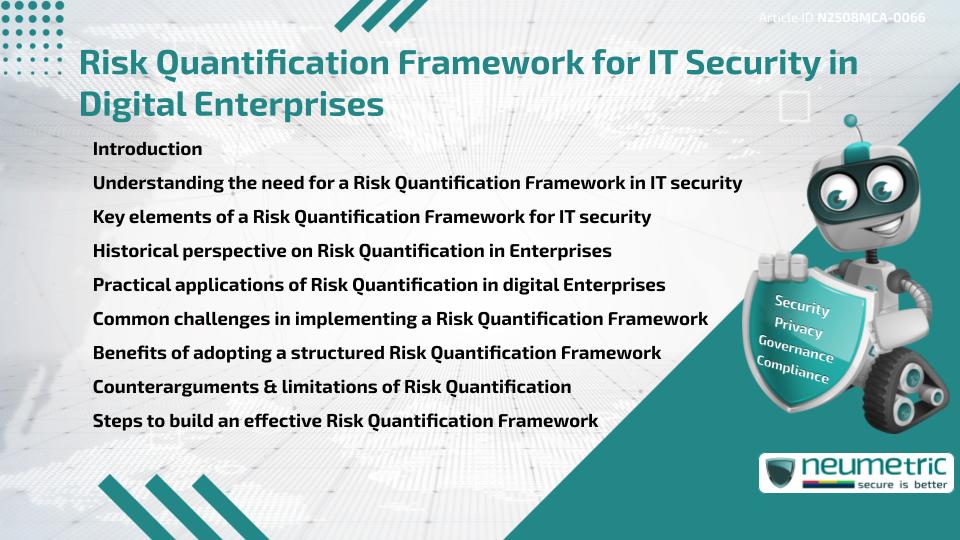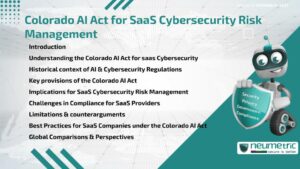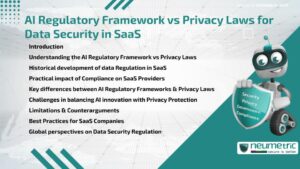Table of Contents
ToggleIntroduction
In today’s interconnected world, Cyber Threats are no longer abstract possibilities but everyday realities for Digital Enterprises. Traditional approaches to security often focus on Compliance Checklists or qualitative Risk Assessments, which lack precision. A Risk Quantification Framework for IT Security allows Organisations to translate Threats into measurable Financial & Operational impacts. This article explores why such a Framework is essential, its key components, historical context, practical applications & the challenges Enterprises face when implementing it.
Understanding the need for a Risk Quantification Framework in IT security
Digital Enterprises handle massive volumes of Sensitive Data, Financial Transactions & Intellectual Property. Without measurable Metrics, Security decisions may rely on intuition rather than Evidence. A Risk Quantification Framework for IT Security provides clarity by calculating the potential Cost of Incidents, Likelihood of Occurrence & the Value of Safeguards. This makes it easier for executives to justify Investments in Cybersecurity in terms that align with Business Objectives.
Key elements of a Risk Quantification Framework for IT security
A structured Framework typically includes:
- Asset Valuation: Determining the Business value of Digital Assets such as Customer Data, Intellectual Property & Financial records.
- Threat Modeling: Identifying the types of Cyber Threats most relevant to the Enterprise.
- Vulnerability Analysis: Assessing weaknesses in Systems, Applications & Networks.
- Probability & Impact measurement: Estimating the Likelihood of Threats & quantifying their potential Financial, Reputational or Legal damage.
- Risk Prioritisation: Ranking Risks to focus resources on the most critical Vulnerabilities.
Together, these elements provide a holistic view of Security Risk & guide Organisations toward informed Decision-making.
Historical perspective on Risk Quantification in Enterprises
Risk Management is not new. Financial Institutions have long used Quantification methods to measure Credit & Market Risks. Over time, these practices migrated into Enterprise Risk Management, where they influenced Operational & Compliance strategies. In IT Security, early approaches were often qualitative, relying on “high, medium or low” categorisations. However, as Digital Enterprises became more dependent on Technology, the need for precision grew. This evolution paved the way for structured methodologies such as Factor Analysis of Information Risk [FAIR], which brought rigor to Risk Quantification in Cybersecurity.
Practical applications of Risk Quantification in digital Enterprises
A Risk Quantification Framework for IT Security can be applied in multiple contexts. For instance, it helps Enterprises evaluate whether to invest in advanced Intrusion Detection Systems or additional Employee Training. It also aids in Insurance negotiations, where quantified Risk Assessments can lower premiums for Organisations with strong controls. Moreover, Boards of Directors benefit from Reports that express Risk in Monetary terms, making Cybersecurity decisions comparable to other Business Risks.
Common challenges in implementing a Risk Quantification Framework
Despite its advantages, adoption is not without hurdles. Data availability is a major challenge, as accurate Quantification requires reliable Incident histories & Asset valuations. Another issue is complexity: translating technical Risks into Financial terms can be difficult without cross-functional expertise. Additionally, some Stakeholders may resist change, preferring traditional Qualitative Assessments. These obstacles can slow down implementation & reduce confidence in the results.
Benefits of adopting a structured Risk Quantification Framework
The benefits outweigh the challenges for most Digital Enterprises. Quantified Risk Assessments improve transparency, support Budget allocation & help align Cybersecurity with Business strategy. They also enable Organisations to demonstrate accountability to Regulators, Customers & Partners. By making Risks tangible, Enterprises can prioritise actions that deliver the highest return on Security Investments. In short, a Risk Quantification Framework for IT security strengthens both Trust & Resilience.
Counterarguments & limitations of Risk Quantification
Critics argue that Risk Quantification can create a false sense of accuracy. Since probabilities & impacts are often based on assumptions, the resulting numbers may not reflect reality. Others note that Quantification requires significant Resources & Expertise, which may not be feasible for smaller Enterprises. Additionally, rapidly evolving Threats can outpace even the most sophisticated models. These limitations remind us that Quantification is a tool, not a guarantee & must be balanced with qualitative judgment.
Steps to build an effective Risk Quantification Framework
Enterprises looking to adopt this approach can follow several steps:
- Define Objectives: Clarify whether the goal is Compliance, Budget justification or Strategic planning.
- Inventory Assets: Catalog all critical IT Assets & assign Business values.
- Collect Data: Gather historical Incident Data, Threat Intelligence & Vulnerability Assessments.
- Apply Quantification Models: Use frameworks like FAIR to estimate Probabilities & Impacts.
- Validate & Refine: Test the model’s assumptions against real-world outcomes & adjust as necessary.
- Integrate into Governance: Embed the Framework into Decision-making processes & Reporting structures.
Through these steps, digital Enterprises can build a reliable foundation for Evidence-based Security Management.
Takeaways
- Risk Quantification translates Cyber Threats into measurable Business Impacts.
- A Risk Quantification Framework for IT security helps align decisions with Enterprise goals.
- Historical methods like FAIR show how Risk modeling has matured in Cybersecurity.
- Implementation challenges include Data Gaps, Complexity & Resistance to change.
- Despite limitations, Quantification improves Transparency, Trust & Resilience.
FAQ
What is a Risk Quantification Framework for IT Security?
It is a structured approach that measures Cyber Risks in Financial & Operational terms to support informed decision-making.
Why do Enterprises need Risk Quantification?
Because it provides measurable data that supports Budgeting, Compliance & Executive-level strategy.
What are the main components of a Risk Quantification Framework?
Asset valuation, Threat modeling, Vulnerability analysis, Probability & Impact measurement & Risk prioritisation.
How does Risk Quantification differ from Qualitative Assessments?
Qualitative methods categorise Risks as high, medium or low, while Quantification assigns numerical values to Probabilities & Impacts.
What are common challenges in implementing Risk Quantification?
Challenges include lack of reliable Data, Modeling complexity & Organisational resistance.
Can smaller Enterprises use Risk Quantification Frameworks?
Yes, but they may need simplified Models due to limited Resources.
Which Frameworks are commonly used in Risk Quantification?
FAIR is one of the most recognised methodologies for Cybersecurity Risk Quantification.
Need help for Security, Privacy, Governance & VAPT?
Neumetric provides organisations the necessary help to achieve their Cybersecurity, Compliance, Governance, Privacy, Certifications & Pentesting needs.
Organisations & Businesses, specifically those which provide SaaS & AI Solutions in the Fintech, BFSI & other regulated sectors, usually need a Cybersecurity Partner for meeting & maintaining the ongoing Security & Privacy needs & requirements of their Enterprise Clients & Privacy conscious Customers.
SOC 2, ISO 27001, ISO 42001, NIST, HIPAA, HECVAT, EU GDPR are some of the Frameworks that are served by Fusion – a SaaS, multimodular, multitenant, centralised, automated, Cybersecurity & Compliance Management system.
Neumetric also provides Expert Services for technical security which covers VAPT for Web Applications, APIs, iOS & Android Mobile Apps, Security Testing for AWS & other Cloud Environments & Cloud Infrastructure & other similar scopes.
Reach out to us by Email or filling out the Contact Form…





